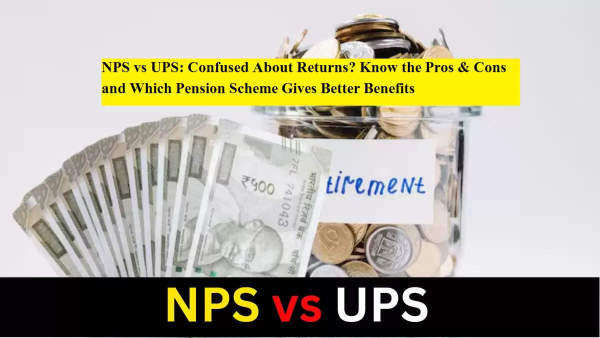
The central government has extended the deadline for employees to opt from the National Pension System (NPS) to the Unified Pension Scheme (UPS) until September 30, 2025. Despite the extension, only around 50,000 out of 3 million eligible central government employees have chosen to shift to UPS. If you're still confused about which scheme is better in terms of retirement returns and benefits, this comparison will help you decide.
🔄 UPS vs NPS: Which Offers Better Retirement Returns?
Case Study (As per PFRDA Calculator):
-
Date of Birth: 1 Jan 1980
-
Joining Date: 1 Jan 2005
-
Retirement Age: 60
-
Service Duration: 35 years
-
Basic Salary: ₹30,000
-
Existing NPS Tier 1 Corpus: ₹10 lakhs
-
Expected Annual Basic Pay Growth: 5%
-
DA Growth: 6%
-
Expected Return on Investment: 10%
-
Annuity Rate: 6%
-
Withdrawal at Retirement: 60%
-
Life Expectancy (Self): 75 | (Spouse): 80
🧾 Comparison Table:
| Component | UPS | NPS |
|---|---|---|
| Monthly Pension (After Retirement) | ₹30,157 + DA | ₹24,223 (Fixed Annuity) |
| One-Time Lump Sum | ₹14,01,650 | Not Applicable |
| Final Withdrawal Amount | ₹64,58,060 | ₹72,66,900 |
| Total Monthly Payout (Post Retirement) | ₹1,17,90,103 | ₹58,13,520 |
| Total Estimated Benefits | ₹1,96,49,812 | ₹1,30,80,421 |
✅ UPS: Pros
-
Assured pension of 50% of last 12 months’ average Basic + DA.
-
Pension increases over time with inflation protection (DA adjustments).
-
Lump sum gratuity benefit after retirement for 6 months of service.
-
60% family pension after employee's death.
-
Government contributes 18.5% (more than NPS’ 14%).
🔻 UPS: Cons
-
Requires minimum 10-25 years of service for full benefits.
-
Early retirement may delay pension processing.
-
Less transparency in investment structure compared to NPS.
✅ NPS: Pros
-
Investment flexibility in Equity, Debt, G-Secs.
-
Potential for higher long-term returns.
-
Portable account – no issue with job/location changes.
-
60% of the corpus can be withdrawn tax-free at retirement.
🔻 NPS: Cons
-
Returns are market-dependent, not fixed.
-
Mandatory to invest 40% in annuity, which offers limited and fixed returns.
-
Actual pension may be lower in poor market conditions.
🧠 Which Is Better for You?
-
If you prefer stable, guaranteed post-retirement income and inflation-adjusted growth, UPS is more secure and rewarding in the long term.
-
If you're comfortable with market risks and want the chance for higher returns with investment flexibility, NPS might work better—especially for younger employees with longer investment horizons.
📌 Final Verdict:
UPS gives higher pension security and total returns based on the case study. But your choice should depend on risk appetite, career stability, and retirement goals. You get only one chance to shift from NPS to UPS, so choose wisely before September 30, 2025.









